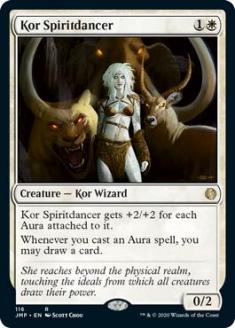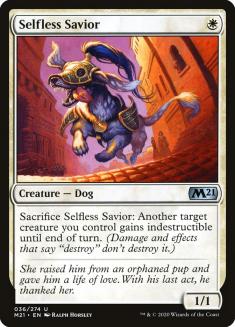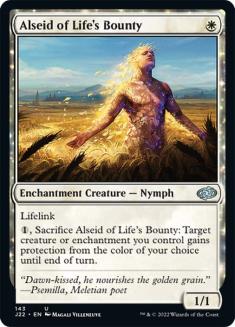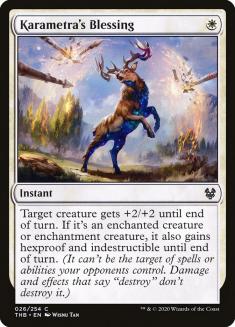One of the biggest surprises to come out of this weekend’s Arena Open was the seemingly (at least according to anecdotal evidence of Twitter and the much-appreciated effort of the Arena Decklists account) out-of-nowhere success of various white-based Aura strategies.
While there doesn’t seem to be a consensus “best version” yet, as one would generally expect with any emerging archetype in Historic at this stage, there are a lot of different variants that we can take a look at.
To start with the basics, let’s take a look at Mono-White.
Creatures (17)
Lands (20)
Spells (23)

So why did this deck (and other versions with light splashes) seem to do so well this weekend?
First we should start with the centerpiece – Kor Spiritdancer, a huge addition from Jumpstart. Kor Spiritdancer, as we’ve seen over the years, is a card so powerful that it is a mainstay in Modern Hexproof despite not having the namesake protection mechanic.
Spiritdancer can singlehandedly win games and quickly snowballs completely out of control – if not outright killing opponents, then providing a massive amount of velocity. It is often, given the keywords it picks up from Auras across formats, insurmountable on both offense and defense.
What are some other factors? First, lean aggressive decks are simply propped up in Best-of-One. Auras, Goblins, Mono-Blue Tempo, Mono-Red, and Gruul all performed well this weekend (and most of which felled me and my ambitious three- and four-color decks in the queues). They’re typically more vulnerable to sideboard interaction and they are smoothed out by the Best-of-One algorithm while feasting on mulligans and stumbles from an opponent.
Sure, this is all well and good to explain away past success, but there’s a reasonable chance that a lot of you are more interested in traditional play following this weekend, so why should you care about these Aura decks?
Look at the way that Gerry Thompson configured his recommended Temur Reclamation deck for this weekend:
Creatures (3)
Lands (31)
Spells (26)

He emphasized expensive damage-based removal that can cover a wide berth of strategies in Magmaquake, Aether Gust – the latter a format mainstay between the strength of Goblins, red decks, and Temur Reclamation – and Mystical Dispute as primary points of interaction.
It’s no secret that loads of folks were gearing up with a high number of Aether Gust, and will likely continue to as long as Goblins remains one of the strongest decks in Historic.
While Kor Spiritdancer might be the hammer, these two seemingly innocuous one-drops do most of the heavy lifting and make these Aura strategies so difficult to penetrate.
There’s a ton of coverage here against damage-based removal at low opportunity cost, and even those Brazen Borrowers hanging out in Gerry’s sideboard are ineffective against Alseid and Karametra’s Blessing.
Another underrated strength of this Mono-White strategy is its ability to actually get through. Flying is an underrated powerhouse in Historic right now – not simply because of Magmaquake (which Mono-Blue rose up to respond to), but also the battlefields littered with Goblin and Zombie tokens.
Angelic Gift might look like nonsense when reading a decklist, but it just kills people. Similarly, Hushbringer (which is nice technology against Goblins) and Gingerbrute have natural evasion, giving more angles of attacks in a format that’s actually pretty good at clogging up battlefields despite its natural power and speed.
Let’s take a look at some other decklists:
Creatures (14)
Lands (22)
Spells (24)

I’m not the biggest fan of giving up Selfless Savior, but Hateful Eidolon and Aphemia, the Cacophony are serviceable pick-ups from this splash. Demonic Vigor is also a card I failed to remember existed, and is another piece of resiliency against removal.
Aphemia in particular seems as if it’s barely gotten its fair shake, but Orzhov Auras has shown to have some legs in Pioneer, so it’s not surprising that it might be worth trying to port to Historic with the addition of Kor Spiritdancer.
Finally, as of Sunday afternoon, a version that has proven that it can have some legs in Best-of-Three as well – with a $2,000 result in the Arena Open by Jeff Pyka, courtesy of Simon Nielsen.
Creatures (16)
Lands (22)
Spells (22)

I love this deck.
On the surface, this Azorius Auras deck looks to be trading some of the “weaker” Auras from Mono-White, such as Solid Footing and Glaring Aegis, for some higher-impact cards that you might used to seeing more out of Mono-Blue Aggro, such as Curious Obsession and Staggering Insight. And that’s true, of course. You’ll have some runaway games where an opponent can’t answer your protected threat that continues to draw cards and cascade your advantage until they die.
The beauty is in the details, though. Like I said, flying is extremely strong in Historic, and Ornithopter has a ton of advantages to being the carrier of Auras – its naturally hard to block and a card with Curious Obsession enchanted on it doesn’t necessarily need to hit hard early. It generates a bonus with All That Glitters, and most importantly it costs zero mana. This makes deploying it and suiting it up easier, and best of all it means that you have fewer shields-down moments with Alseid of Life’s Bounty.
The commitment to the strength of flying here is so high that Jeff played Arcane Flight – again, another Aura I didn’t know existed – and Aether Tunnel as another evasion generator, likely intended as a simple nail-in-the-coffin with Kor Spiritdancer.
Adanto Vanguard is another card that is much stronger when paired with blue than it would be in other variants of Auras. Simply putting a Curious Obsession on a creature that’s hard to kill and block effectively is a winning recipe, whereas opponets can ignore an Adanto Vanguard with a Glaring Aegis on it in many circumstances.
The sideboard is clean and elegant too, and makes a ton of sense to me the way that Historic has developed. Getting some bonus points out of All That Glitters with the artifact hammers is a nice bonus, but there’s just a commitment here to staying lean and keeping interaction cheap so that you can continue to play your primary gameplan. I also like the use of Hushbringer here in the sideboard a bit better – despite its power level against Goblins, the risk of Uro, Titan of Nature’s Wrath just showing up on Turn 3 is a bit too steep.
Azorius Auras is where I’d start after this weekend, and I wouldn’t make very many changes to this initial list to begin with:
Creatures (16)
Lands (22)
Spells (22)

Again, nothing major, but I do believe that the biggest strength of the Auras deck is its ability to so efficiently protect its threats, so I’ve made a few changes to reinforce that strength – cutting the Aether Tunnels for Karametra’s Blessing, and adding another Alseid.
While Temur Reclamation continues to move through formats and assert its dominance, the Arena Open has shown us there are tons of decks that can rise up, and ultimately the way that Reclamation is being built can be exploitable. Jumpstart has given Historic a ton of tools, and I don’t think we’re anywhere near it being solved. The format is powerful, but it manifests itself in a lot of different ways through a variety of macro-archetypes.
Sure, there are some issues, and I understand a lot of folks’ grievances, but I do genuinely believe that Historic is a fun format with a ton of potential, and no matter what type of gameplay you seek, you can probably find it.
If you’re sick of how things look in Standard, give Auras a try.






